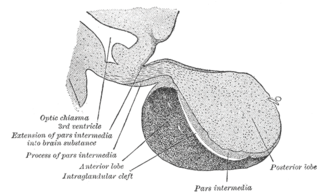Related Research Articles

Endocrinology is a branch of biology and medicine dealing with the endocrine system, its diseases, and its specific secretions known as hormones. It is also concerned with the integration of developmental events proliferation, growth, and differentiation, and the psychological or behavioral activities of metabolism, growth and development, tissue function, sleep, digestion, respiration, excretion, mood, stress, lactation, movement, reproduction, and sensory perception caused by hormones. Specializations include behavioral endocrinology and comparative endocrinology.

The endocrine system is a messenger system comprising feedback loops of the hormones released by internal glands of an organism directly into the circulatory system, regulating distant target organs. In vertebrates, the hypothalamus is the neural control center for all endocrine systems. In humans, the major endocrine glands are the thyroid gland and the adrenal glands. The study of the endocrine system and its disorders is known as endocrinology.

A hormone is a class of signaling molecules in multicellular organisms that are sent to distant organs by complex biological processes to regulate physiology and behavior. Hormones are required for the correct development of animals, plants and fungi. Due to the broad definition of a hormone, numerous kinds of molecules can be classified as hormones. Among the substances that can be considered hormones, are eicosanoids, steroids, amino acid derivatives, protein or peptides, and gases.

Pro-opiomelanocortin (POMC) is a precursor polypeptide with 241 amino acid residues. POMC is synthesized in corticotrophs of the anterior pituitary from the 267-amino-acid-long polypeptide precursor pre-pro-opiomelanocortin (pre-POMC), by the removal of a 26-amino-acid-long signal peptide sequence during translation. POMC is part of the central melanocortin system.

Prolactin (PRL), also known as lactotropin, is a protein best known for its role in enabling mammals to produce milk. It is influential in over 300 separate processes in various vertebrates, including humans. Prolactin is secreted from the pituitary gland in response to eating, mating, estrogen treatment, ovulation and nursing. It is secreted heavily in pulses in between these events. Prolactin plays an essential role in metabolism, regulation of the immune system and pancreatic development.

A major organ of the endocrine system, the anterior pituitary is the glandular, anterior lobe that together with the posterior lobe makes up the pituitary gland (hypophysis). The anterior pituitary regulates several physiological processes, including stress, growth, reproduction, and lactation. Proper functioning of the anterior pituitary and of the organs it regulates can often be ascertained via blood tests that measure hormone levels.

Cortisol is a steroid hormone, in the glucocorticoid class of hormones. When used as a medication, it is known as hydrocortisone.

A freemartin or free-martin is an infertile female cattle with masculinized behavior and non-functioning ovaries. Phenotypically, the animal appears female, but various aspects of female reproductive development are altered due to acquisition of anti-Müllerian hormone from the male twin. Genetically the animal is chimeric: karyotypy of a sample of cells shows XX/XY chromosomes. The animal originates as a female (XX), but acquires the male (XY) component in utero by exchange of some cellular material from a male twin, via vascular connections between placentas: an example of microchimerism. The chimerism is mainly present in the hematopoietic stem cells.

Endocrine disruptors, sometimes also referred to as hormonally active agents, endocrine disrupting chemicals, or endocrine disrupting compounds are chemicals that can interfere with endocrine systems. These disruptions can cause cancerous tumors, birth defects, and other developmental disorders. Found in many household and industrial products, endocrine disruptors "interfere with the synthesis, secretion, transport, binding, action, or elimination of natural hormones in the body that are responsible for development, behavior, fertility, and maintenance of homeostasis ."

Endocrine glands are ductless glands of the endocrine system that secrete their products, hormones, directly into the blood. The major glands of the endocrine system include the pineal gland, pituitary gland, pancreas, ovaries, testes, thyroid gland, parathyroid gland, hypothalamus and adrenal glands. The hypothalamus and pituitary glands are neuroendocrine organs.
Reproductive biology includes both sexual and asexual reproduction.

Captive breeding, also known as captive propagation, is the process of maintaining plants or animals in controlled environments, such as wildlife reserves, zoos, botanic gardens, and other conservation facilities. It is sometimes employed to help species that are being threatened by the effects of human activities such as climate change, habitat loss, fragmentation, over hunting or fishing, pollution, predation, disease, and parasitism.
Non-tropic hormones are hormones that directly stimulate target cells to induce effects. This differs from the tropic hormones, which act on another endocrine gland. Non-tropic hormones are those that act directly on targeted tissues or cells, and not on other endocrine gland to stimulate release of other hormones. Many hormones act in a chain reaction. Tropic hormones usually act in the beginning of the reaction stimulating other endocrine gland to eventually release non-tropic hormones. These are the ones that act in the end of the chain reaction on other cells that are not part of other endocrine gland. The Hypothalamic-pituitary-adrenal axis is a perfect example of this chain reaction. The reaction begins in the hypothalamus with a release of corticotropin-releasing hormone/factor. This stimulates the anterior pituitary and causes it to release Adrenocorticotropic hormone to the adrenal glands. Lastly, cortisol (non-tropic) is secreted from the adrenal glands and goes into the bloodstream where it can have more widespread effects on organs and tissues. Since cortisol is what finally reaches other tissues in the body, it is a non-tropic hormone. CRH and ACTH are tropic hormones because they act on the anterior pituitary gland and adrenal glands, respectively, both of which are endocrine glands. Non-tropic hormones are thus often the last piece of a larger process and chain of hormone secretion. Both tropic and non-tropic hormones are necessary for proper endocrine function. For example, if ACTH is inhibited, cortisol can no longer be released because the chain reaction has been interrupted. Some examples of non-tropic hormones are:

Estetrol (E4), or oestetrol, is one of the four natural estrogenic steroid hormones found in humans, along with estrone (E1), estradiol (E2), and estriol (E3), estetrol is a major estrogen in the body. In contrast to estrone and estradiol, estetrol is a native estrogen of fetal life. Estetrol is produced exclusively by the fetal liver and is found in dectable levels only during pregnancy, with relatively high levels in the fetus and lower levels in the maternal circulation.

Teleost leptins are a family of peptide hormones found in fish (teleostei) that are orthologs of the mammalian hormone leptin. The teleost and mammalian leptins appear to have similar functions, namely, regulation of energy intake and expenditure.

Saliva testing or Salivaomics is a diagnostic technique that involves laboratory analysis of saliva to identify markers of endocrine, immunologic, inflammatory, infectious, and other types of conditions. Saliva is a useful biological fluid for assaying steroid hormones such as cortisol, genetic material like RNA, proteins such as enzymes and antibodies, and a variety of other substances, including natural metabolites, including saliva nitrite, a biomarker for nitric oxide status. Saliva testing is used to screen for or diagnose numerous conditions and disease states, including Cushing's disease, anovulation, HIV, cancer, parasites, hypogonadism, and allergies. Salivary testing has even been used by the U.S. government to assess circadian rhythm shifts in astronauts before flight and to evaluate hormonal profiles of soldiers undergoing military survival training.

Pyura pachydermatina is a sea tulip, a solitary species of tunicate in the suborder Stolidobranchia. It is native to shallow waters around New Zealand.

21-Deoxycortisol, also known as 11β,17α-dihydroxyprogesterone or as 11β,17α-dihydroxypregn-4-ene-3,20-dione, is a naturally occurring, endogenous steroid related to cortisol (11β,17α,21-trihydroxyprogesterone) which is formed as a metabolite from 17α-hydroxyprogesterone via 11β-hydroxylase.
Kisspeptin, neurokinin B, and dynorphin (KNDy) neurons are neurons in the hypothalamus of the brain that are central to the hormonal control of reproduction.

Rebecca M. Calisi Rodriguez is an American neuroendocrinologist, wildlife biologist, and National Geographic Explorer. She is an Associate professor of Neurobiology, Physiology, and Behavior in the College of Biological Sciences at the University of California, Davis. Calisi leads a research team that studies how the brain controls sexual behavior, reproduction, and parental care, and how this changes under stress. As the Director for Science Communications at UC Davis, Calisi also studies science communication and advocates for inclusivity, equity, and diversity in STEM.
References
- ↑ Ganswindt, André; Brown, Janine L.; Freeman, Elizabeth W.; Kouba, Andrew J.; Penfold, Linda M.; Santymire, Rachel M.; Vick, Mandi M.; Wielebnowski, Nadja; Willis, Erin L.; Milnes, Matthew R. (2012-01-04). "International Society for Wildlife Endocrinology: the future of endocrine measures for reproductive science, animal welfare and conservation biology". Biology Letters. 8 (5): 695–697. doi:10.1098/rsbl.2011.1181. ISSN 1744-9561. PMC 3440958 . PMID 22219389.
- ↑ Kersey, David C.; Dehnhard, Martin (July 2014). "The use of noninvasive and minimally invasive methods in endocrinology for threatened mammalian species conservation". General and Comparative Endocrinology. 203: 296–306. doi: 10.1016/j.ygcen.2014.04.022 . ISSN 0016-6480. PMID 24798579.
- 1 2 Ganswindt, André; Brown, Janine L.; Freeman, Elizabeth W.; Kouba, Andrew J.; Penfold, Linda M.; Santymire, Rachel M.; Vick, Mandi M.; Wielebnowski, Nadja; Willis, Erin L.; Milnes, Matthew R. (2012-10-23). "International Society for Wildlife Endocrinology: the future of endocrine measures for reproductive science, animal welfare and conservation biology". Biology Letters. 8 (5): 695–697. doi:10.1098/rsbl.2011.1181. ISSN 1744-9561. PMC 3440958 . PMID 22219389.
- ↑ Walker, Brian G.; Boersma, P. Dee; Wingfield, John C. (2005-01-01). "Field Endocrinology and Conservation Biology". Integrative and Comparative Biology. 45 (1): 12–18. doi: 10.1093/icb/45.1.12 . ISSN 1540-7063. PMID 21676739. S2CID 205114800.
- ↑ Kersey, David C.; Dehnhard, Martin (2014-07-01). "The use of noninvasive and minimally invasive methods in endocrinology for threatened mammalian species conservation". General and Comparative Endocrinology. 203: 296–306. doi: 10.1016/j.ygcen.2014.04.022 . ISSN 0016-6480. PMID 24798579.
- 1 2 Koren, Lee; Mokady, Ofer; Karaskov, Tatyana; Klein, Julia; Koren, Gideon; Geffen, Eli (February 2002). "A novel method using hair for determining hormonal levels in wildlife". Animal Behaviour. 63 (2): 403–406. doi:10.1006/anbe.2001.1907. ISSN 0003-3472. S2CID 53200273.
- ↑ Wimsatt, Jeffrey; O'Shea, Thomas J.; Ellison, Laura E.; Pearce, Roger D.; Price, Valerie R. (January 2005). "Anesthesia and Blood Sampling of Wild Big Brown Bats (Eptesicus Fuscus) with an Assessment of Impacts on Survival". Journal of Wildlife Diseases. 41 (1): 87–95. doi:10.7589/0090-3558-41.1.87. ISSN 0090-3558. PMID 15827214. S2CID 46731679.
- ↑ Palme, R (2012-08-01). "Monitoring stress hormone metabolites as a useful, non-invasive tool for welfare assessment in farm animals". Animal Welfare. 21 (3): 331–337. doi:10.7120/09627286.21.3.331. ISSN 0962-7286.
- ↑ Millspaugh, Joshua J.; Washburn, Brian E. (September 2004). "Use of fecal glucocorticoid metabolite measures in conservation biology research: considerations for application and interpretation". General and Comparative Endocrinology. 138 (3): 189–199. doi:10.1016/j.ygcen.2004.07.002. ISSN 0016-6480. PMID 15364201.
- ↑ Sapolsky, Robert M.; Romero, L. Michael; Munck, Allan U. (2000-02-01). "How Do Glucocorticoids Influence Stress Responses? Integrating Permissive, Suppressive, Stimulatory, and Preparative Actions*". Endocrine Reviews. 21 (1): 55–89. doi: 10.1210/edrv.21.1.0389 . ISSN 0163-769X. PMID 10696570.